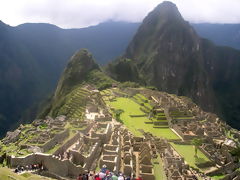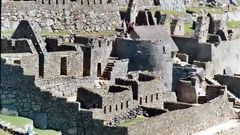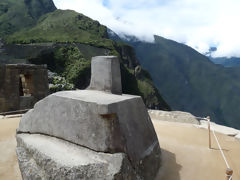 |
Related pages: |
 It's
only in 1911 that Bingham, American archeologist, discovered Machu
Picchu, by hazard. He was, in fact, he was surprised to find out that in
this lost city lived a couple of Indians cultivating the terraces, when the
place has been searched for centuries by the archeologists. Machu Picchu
is without any doubt, the most spectacular pre-Columbian monument of South
America, for the importance of its constructions as for the incredible splendor
of the site; even, it has become cultural patrimony of the Humanity.
It's
only in 1911 that Bingham, American archeologist, discovered Machu
Picchu, by hazard. He was, in fact, he was surprised to find out that in
this lost city lived a couple of Indians cultivating the terraces, when the
place has been searched for centuries by the archeologists. Machu Picchu
is without any doubt, the most spectacular pre-Columbian monument of South
America, for the importance of its constructions as for the incredible splendor
of the site; even, it has become cultural patrimony of the Humanity.
Machu Picchu is at 12 km from Cuzco by the Andean train, an epic trip for itself... Bellow the ruins, a minibus will drive you to the site itself, at 2.350 m of altitude.
Machu Picchu hasn't lost anything of its mystery: was it a fortress installed to prevent an invasion of Amazonian tribes, was it a religious capital or just a place of cult dedicated to the sun, was it the last refuge of Sun Virgins, or the last Inca's capital? They say that Manco Capac, the last Inca king, wanted by the Spanish, hid there. And Pizarro never found the location of Machu Picchu. This can be explained easily: Machu Picchu is on the top of a mountain, cut in such a way that the site is perfectly invisible from the valley.
Machu Picchu (on 20 hectares) is divided in several quarters separated mostly by the central esplanade.
We recognize the religious buildings and the houses inhabited by notables for the stones which are perfectly joined. For the other houses (the farmer's for example) Incas used soil bricks (lime and soil) between stones more roughly cut.
Walls were inclined toward the inside so they could resist earthquakes. Notice that these very huge walls were covered only with fragile roofs made of rush and reed. At last you will notice that, from the top of the mirador, the whole Machu Picchu site is green but below everything becomes gray.
In the entry, before the cultivated terraces, you can see the ingenious irrigation system. Arable soil was brought from the valley.
The site has a warm and humid weather (24°C to 13°C), with rains from November to March.
From this place that dominates the whole site, you will have the most beautiful view. Behind the mirador ends the Inca's Trail. On the way back, going through the main door of the citadel, you will notice the ingenious closing system: the stone ring above and the two handles in the holes on the sides.
Just bellow the citadel door. A cavern bellow the central tower which was maybe an Inca tomb. Note that the steps and the niches carved in the rock. The central tower has a horseshoe shape (torreon) that we will find often on the Inca's sites.
 An
incredible street composed of a series of little basins arranged in a row. These
fountains were without any doubt used for ritual ablutions. They worked for
longtime until the water was derived for the Turistas Hotel! - In that
place, you can see better the different quarters, separated by the big grass
esplanade where eats the last Machu Picchu alpaca. Why the last? Because
all its partners imported like it from the Altiplano (at 4.000 m and
more) are dead because of... the grass, too tender here at 2.500 m ! They are
used to eat hard grass, the teeth of these poor alpacas fell off, and they got
different diseases. Just one of them has survived, nobody knows why!
An
incredible street composed of a series of little basins arranged in a row. These
fountains were without any doubt used for ritual ablutions. They worked for
longtime until the water was derived for the Turistas Hotel! - In that
place, you can see better the different quarters, separated by the big grass
esplanade where eats the last Machu Picchu alpaca. Why the last? Because
all its partners imported like it from the Altiplano (at 4.000 m and
more) are dead because of... the grass, too tender here at 2.500 m ! They are
used to eat hard grass, the teeth of these poor alpacas fell off, and they got
different diseases. Just one of them has survived, nobody knows why!
In this side, between the fountains street and the Three Windows Temple, you will find the Inca's house, with its indoor patios. You can recognize it also for the type of the stones, especially well cut and with the remains of a mortar. Just above de northern stair (which limits the esplanade on one side) is the house of the priest, the beginning of the religious quarter. Behind, is the sacred place, surrounded by two other buildings: The 3 Windows Temple, which is the only one with megalithic construction, and the great temple which, like in Pisac, presents 7 niches on the fond. Going along the left side of the great temple, you will find one of the most curious buildings of the site: the sacristy where priests got ready is called also chamber of the ornaments. On the wall du fond, there are trapezoidal niches and a huge stone banquette. One of its presumed uses could have being to the "drying" of mummies, before placing them in their sepultures. In fact, the humid weather of this region risked making them turn rot. The right entry wall proposes the famous 22 angles stone.
 In
the extension of the temples, through several stairs, you arrive to the astronomic
observatory, the higher point of the town, and the most mysterious.
In
the extension of the temples, through several stairs, you arrive to the astronomic
observatory, the higher point of the town, and the most mysterious.
On the entry of the platform there is the sundial (on the right of three small steps), a fine and very strange rock rises. Look at it closer: the rock represents exactly the same shape of the surrounding mountains, reproducing them in a very accurate reduction . From the Wayna Picchu, compare these mountains one by one.
The central "table" is surmounted with an angular stone with precise geometric forms: it's the solar calendar. Its shadow, projected over the multiples table angles let the Inca astronomers make their astronomical calculations. It's one of the most rare ones that have remained, because Spanish never found it .
It's a place in two levels where Bingham found sepultures. To notice on the floor a huge flat stone that makes us think of the shape of a condor, with the head towards the sunrise. This could have being a place for sacrifice: a small canal goes through the floor so blood could feed the Earth, a divinity for the Incas. The rooms near the big rock have been baptized (without having many proofs) s Chamber of Tortures.
 This
quarter is located at a higher level of the prisons group. The presence of mortars
in one of the large rooms makes us think that this area was dedicatedto the
handcraft and domestic activities. By the way, notice the number of niches and
projecting stones.
This
quarter is located at a higher level of the prisons group. The presence of mortars
in one of the large rooms makes us think that this area was dedicatedto the
handcraft and domestic activities. By the way, notice the number of niches and
projecting stones.
In the extension of the Industrial Quarter. A group of houses with a quite simple architecture, followed by a group of Three Gates. The presence of rooms without windows let suppose that it could be the place where lived women, or the Virgins Temple.